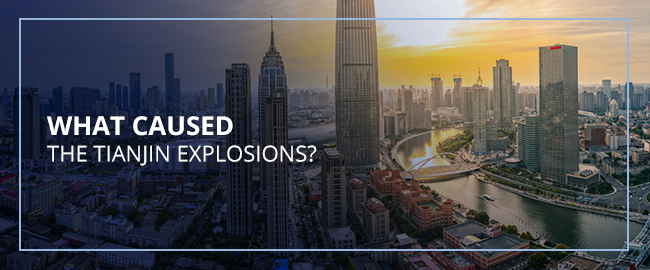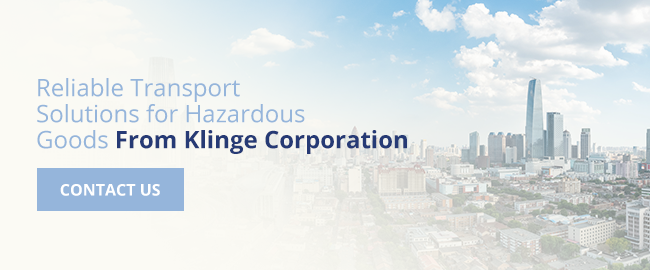In August 2015, a warehouse in the port of Tianjin in northern China experienced two major explosions. According to the China Earthquake Networks Centre, the first explosion was as powerful as if three tons of TNT had detonated, and the second was equivalent to 21 tons detonating. This second explosion was so significant that astronauts orbiting Earth on the ISS could see it from space.
Years later, the Tianjin chemical warehouse explosions should continue to serve as a reminder to anyone working in the storage and handling of hazardous materials of what can happen if they fail to follow the proper procedures.
Table of Contents
The Aftermath
The pictures and videos of the explosions and a city in flames are sure to leave an impression, but as the smoke settled, the aftermath was even more devastating. The final death toll was 173, with many more people injured. More than 100 of the victims were first responders attempting to stop the destruction and save others’ lives.
In addition to the deaths and injuries that devasted many families, the explosions also destroyed a large amount of equipment. The State Council reported damage to 12,428 cars, 7,533 shipping containers and 304 buildings. All this added up to over $1 billion in damage.
The impact of the explosions reached beyond the industrial center of Tianjin into residential areas, as well, forcing thousands of people out of their homes. It was enough to destroy buildings more than a kilometer away.
The explosion also affected the environment, which is no surprise, considering the warehouse where the blasts originated stored 700 tons of highly toxic substances. The crater left by the explosion filled in with toxic water. Some water samples taken from the area included the toxic chemical sodium cyanide and toxins in amounts well over 300 times above the acceptable limit. Fortunately, the accidents only affected the marine life in Tianjin and didn’t extend to the rest of Bohai Bay, and there were no additional deaths from the disaster due to poisoning.
Causes of the 2015 Tianjin Explosions
So, what caused the Tianjin explosions? We can look at both the immediate causes and the more significant underlying reasons that contributed to such a devastating event. The origin of the disaster was a container of dry nitrocellulose. The container got overheated, and the wetting agents inside had evaporated, which led to spontaneous ignition.
The fire caused by the dry nitrocellulose reached another hazardous substance stored in the warehouse: ammonium nitrate fertilizer. The flames caused the fertilizer to explode. Of course, with so many dangerous substances around, it is no surprise that another explosion would follow.
It’s essential to note that what happened in that warehouse was not a natural disaster. Ultimately, the Tianjin, China, explosion cause was a preventable problem entirely due to human mismanagement. Eventually, well over 100 people were to blame for the incident. Some were negligent, while others played a more active role in knowingly putting people in danger.
The warehouse operator, a company called Tianjin Ruihai International Logistics, was storing staggering amounts of hazardous substances illegally, and doing so with sorely lacking safety procedures.
What We Can Learn From the Tianjin Disaster
So, what can we learn from this terrible disaster? One simple takeaway is for any company storing nitrocellulose. This hazardous material requires secure storage in containers, away from sunlight, heat, combustibles and ignition sources. The Tianjin explosions serve as a painful reminder of several things, in hindsight.
1. Oversight Is Critical for Maintaining Safety
First, this incident demonstrates how vital it is to have oversight from government agencies or other recognized bodies that create rules and ensure companies comply to prevent disasters like Tianjin. While these regulations may seem to make your job harder at times or put undue stress on your company, the reality is that they are entirely necessary. In the case of Tianjin, the oversight was lacking, and the result was tragic.
In the U.S., agencies like the Occupational Safety and Health Administration, Environmental Protection Agency, Department of Transportation and the Department of Homeland Security all influence the storage, handling and transporting of hazardous materials. Safe procedures start with recognizing how critical the regulations from these agencies are.
2. Workers Must Be Aware of Hazards and Have Hazmat Training
Hazardous materials don’t only get a special label, though that is part of it. Workers need training on how to handle, store and ship these goods safely. Not only must they have the right training, but they should also know what chemicals they are dealing with. HazCom dictates that employers are responsible for training their team on how to deal with the specific hazards they face there.
Employers must also have a HazCom plan written down, which outlines how they will go about informing their employees of hazards, maintain safety data sheets and train their employees. To ensure total transparency, something that was clearly lacking in the case of the Tianjin warehouse, employers must maintain a chemical inventory list, which identifies every hazardous chemical in the workplace, how much is there and its location.
3. Facilities Containing Hazmat Need Emergency Prevention and Response Plans
Finally, companies that work with hazardous materials should prepare for an emergency. Thinking about the possibility of an emergency should start with a prevention strategy, but it shouldn’t stop there. An emergency response plan is also crucial. Consider the most efficient and effective ways employees should respond in the event of a hazardous material igniting or spilling, for example. You can even contact your local first responders to apprise them of any unique hazards in your facility. That way, they’ll be ready to help if it’s ever necessary.
Reliable Transport Solutions for Hazardous Goods From Klinge Corporation
If you transport hazardous goods, you need solutions customized to help you maintain the highest possible levels of safety. Klinge Corporation understands the many factors that play into the safe transport of chemicals, especially when those chemicals are hazardous.
Klinge is an innovative provider of transport refrigeration equipment, including equipment for safely shipping chemicals using explosion-proof and redundant refrigeration systems. We offer container cooling units, refrigerated tankers, freezer units, pharmaceutical containers and more. Contact us today to talk to a specialist or request a quote and learn more about how Klinge can equip you to transport hazardous goods safely.



